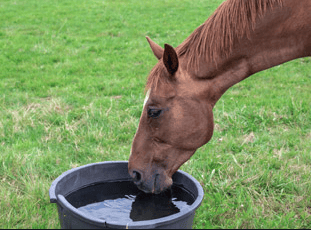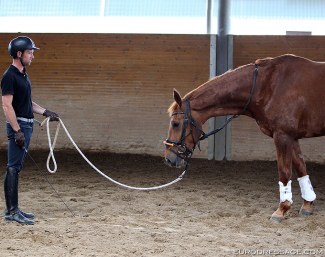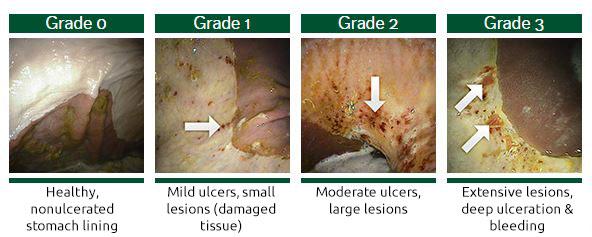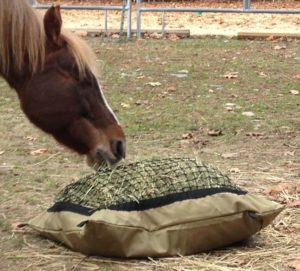 | Water - 5-15 gallons a day
- fresh water daily
|
Salt- horses need salt (93% NaCl - sodium chloride) EVERY day
- 2 U.S TBSP per 1,100 pound horse (12 grams per day for full-sized horse)
- 1 tsp = 2 grams of sodium
- palatability no more than 1 tbsp per meal
- 1 tbsp per 500 pounds of body weight
- best way offer granulated salt free-choice in a small container
- if ignores add to horse's meal
- make sure to calculate the amount of salt in commercial feeds and supplements
- salt blocks should be available for additional needs
| |
 | Electrolytes - minerals in blood that carry an electric charge
- affect hydration, blood pH, play important role in body
- sodium, potassium, chloride
- only way horse can replace these is through their diet
|
How can horses get electrolytes?
- salt blocks do not work because horse's tongues are not rough enough
- you can not preload electrolytes
- putting it in water can cause a horse to drink less
What does research show?
- daily electrolyte supplementation in GRAIN is a safe way to replace lost electrolytes from exercise, hot weather, shipping
- 50-75 grams of LOOSE salt to a horse's diet divided between the two grain feedings
- "topdressing" gives the horse what they need and any extra is eliminated as waste
Food- trickle feeders
- designed to constantly take in food throughout the day (50-80% of day)
- 17-20 hours grazing on forage
- foundation diet must be forage
- 1-2% of body weight in forage
- high quality hay
- multi-vitamin supplement
- bridge the gap and ensure horse is getting all the vitamins and minerals they need
| |
 | Companionship - herd animals
- comfort in a group
- happy horse is a socialized horse live as part of a herd
|

Shelter
- hardy
- cope with heat and cold regulating own body temperature
- needs a place get away from elements
- safe and sturdy
- shade and escape heat in summer
- protection from harsh wind, snow, freezing rain
- NOT a stall
- can cause colic
- long-term joint health
- standing still
- TURN OUT IS BEST
- regular maintenance and wellness schedule with horse's veterinarian
- dental schedule
- vaccination schedule
- deworming schedule
- optimal hoof health
- consistent maintenance schedule with a farrier
- every 6-8 weeks
Supplements
- healthy hooves
- resilient joints
- proper digestion
- shiny coat
- NOT EVERY HORSE needs them
 | Training - working with horse one-on-one
- professional, reputable trainer can make working with your horse safer, more productive, less stressful, and more fun
|
- paddock, pasture, to relax and stroll
- work with horse every day
- barbed wire NOT okay
Day in a life of a free will horse
- EAT, SLEEP, REPEAT
- 50-80% of day grazing
- sleeping
- short periods of time throughout day and night
- horses can sleep standing up because they have "stay apparatus"
- horse can lock his legs and relax his muscles
- horse stands with one hind leg cocked and resting, head hanging low, ears, lips drooping, eyes fully or partially closed
- horses can sleep lying down
- most lie down for brief period once daily
- flat on side
- propped up on their chests with their legs folded beneath them
- because of their size lying down is not as relaxing than standing
- the weight of horse's body puts pressure on internal organs cause stress on heard and lungs
- different stages of sleep - different brain waves
- slow-wave sleep
- easy to rouse
- quality is light
- REM (paradoxical)
- brain active, experience dreams
- muscles very relaxed
- more difficult to waken
- horse MUST lie down to experience
- if a horse can not lie down they can be sleep deprived
Dealing with the Elements- Cold
- Horse grow long hair in winter
- have muscles under skin that raises hair
- traps air in the fluffy coat
- worse than cold is wind and wet
- turn tail toward wind, stand next to each other
- shivering generates heat
- digestion generates heat
- Heat
- sweat
- evaporation helps cool body
- sponging off a horse with water after a ride does the same thing
- heat brings insects
- at best annoy and distract them from eating or sleeping
- at worst draw blood, painful bites, and harass until frantic for relief
- have subcutaneous muscles that can make certain portions of skin twitch rapidly
- swishing tail
|  |
 | - esophagus
- peristalsis - swallowing
- a wave of contractions in the muscles ringing the esophagus pushes food along
- can see the muscles along bottom of horse's neck
|
- stomach
- esophagus empties into stomach
- ONLY ONE WAY
- horses can not vomit, or burp
- digestive issues are serious and life threatening
- nonruminants - simple stomach
- small relative to animal's overall size
- maximum 4 gallons
- functions best with 2 1/2 gallons of food
- small amounts of food at frequent intervals
- stomach fills as horse eats and when it's 2/3 full digested food begins to exit to small intestines
- if too much food at one time material is rushed out of stomach
- won't be properly digested
- process is designed to accommodate the leisurely eating habits of a grazing animal
|  |
 | - small intestines
- various enzymes act on fat, protein, carbohydrates
- absorbed through intestinal wall into bloodstream
- large meals certain enzymes not as effective
- muscle contractions move the contents
- mostly fibrous material & water
- through small and into large intestines
|
- cecum
- large capacity and relatively slow
- bacteria needs time to ferment and break down fiber
|  |
 | - large intestines
- most useable nutrients and water have been absorbed
- formed into fecal balls
|
Colic - all encompassing term used to describe ANY kind of abdominal pain
- eating too much grain
- not having enough roughage
- usually requires surgery
- leading cause of death in adult horses
| |
 | Gastric Ulcers - another common ailment
- large quantities of grain
|
Proper management is no guarantee against colic or other digestive ailments BUT minimizes the risk
Proper Management
- imitate natural diet as much as possible
- relying on roughage (hay or pasture) MAJORITY of horse's daily calories
- little and often
- use slow feeders for hay - free eating on pastures
- gains ONLY as necessary
- multiple small meals 2-3 times a day NOT big ones
- use slow feeders
 | Pray Animal - Eyes on side of head can see 330 without turning
- when head turning 360
- good vision better than dog's and cat's almost as good as human
- keen sense of hearing
- keen sense of smell
- ears can swivel
- flight NOT fight
- speed is their tool
- "spook" intrinsic and central to horse's being
- good training can help overcome this innate fear
- carefully engineering of GOOD experiences, desensitizing, and establishing trust
- a good trainer doesn't punish spook
- allowing a horse to slowly be adjusted
- horses can learn to suppress their flight instincts through proper training and trust is remarkable
- ignorance
- assume horse is misbehaving
- she is frightened
- DO NOT punish a scared horse
|





























No comments:
Post a Comment
Thank you for taking the time to add comments. I look forward to reading them.